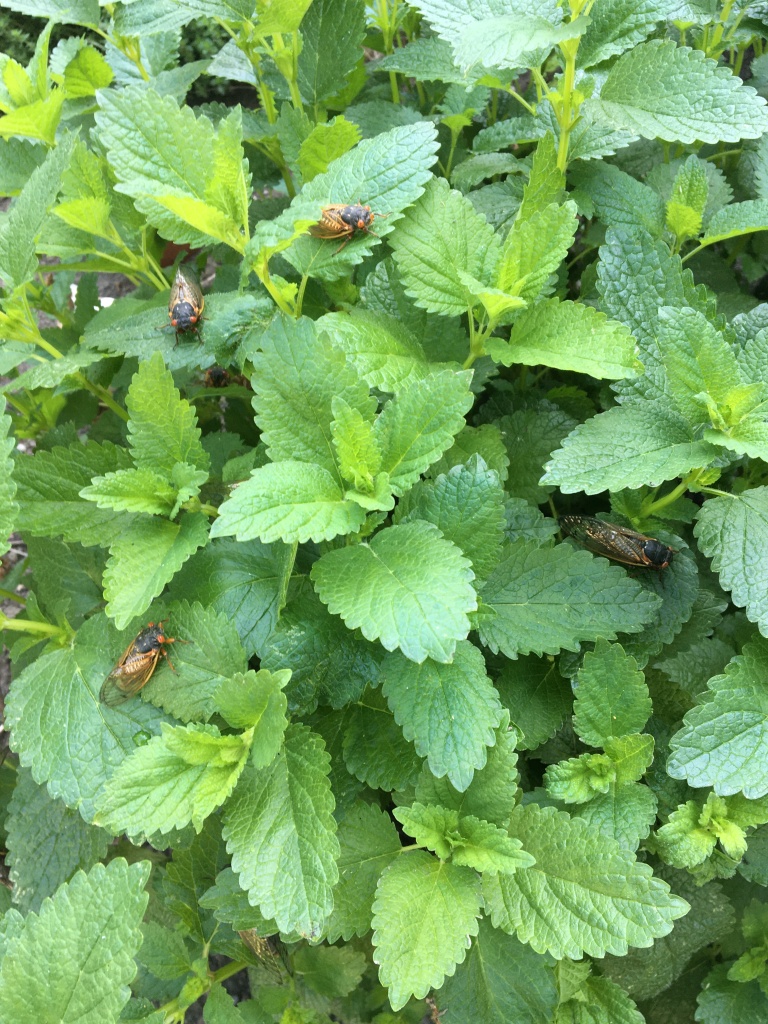
Here’s a post from our good radio, gardening and music friend across the pond Justin Patrick Moore about some bugs that are about in his back yard in Cincinnati at the moment. We’ve never even heard of them over here!
The seventeen year cicadas are at it again. This generation of periodical cicadas has been dubbed Brood X. The periodical cicadas have the latin name of Magicicada septendecim, and have a really interesting life cycle. In southwestern Ohio they are of the kind that come out every seventeen years. These insects spend around 99.5% of their long life underground as nymphs, feeding on fluids from tree roots in the eastern United States. In the spring of their 17th year the mature cicada emerges between late April and early June at a given locality, depending on temperature, and when they come out, they are usually in huge numbers. They’ve been creeping out of the ground slowly the past few weeks, but this past Saturday was the first day I saw a bunch of them. The temperature of the soil has to reach a certain temperature before they really start coming out of the ground, making little holes that they then emerge from. The soil has to get about 17.9 °C (64 °F) before they are ready to get busy with each other propagating a new brood which is what they will spend the next four to six weeks doing. To attract a mate the males of the species have to make a long sonorous drone, that gets louder in the neighborhood as more and more cicadas come out of the ground and start flying and flitting about. Mostly they like to hang out on trees. Apparently in the eastern U.S. where these little buggers live, billions are going to emerge. That’s a lot of cicadas.

This is the third time in my life that I’ve seen the cicada’s. The first time was when I was a kid in 1987. Unfortunately as a kid I was rather cruel to these little things. Hopefully I’ve already worked off the karma I generated by being mean to bugs. (Be nice to the cicadas as they don’t hurt nobody and help aerate the soil!) The next time was in 2004 and I made a recording of them to use in the drone & experimental ambient music I am so fond of. I still have the recording but don’t know if I ever actually made a track with the sounds. That first time around too, there was a local pizzeria called Snappy Tomato Pizza. They made a jingle for Snappy Cicada Pizza that has stuck in my head ever since I heard it. They had a promotion that if anyone came in and ate a cicada they’d get a free pizza. Apparently they also had them to use as a pizza topping – but I think that was just part of their marketing ploy that has now become local folklore. Hear the jingle here.
Here is some cicada music: https://benseretan.bandcamp.com/album/cicada-waves

According to a story I saw on NPR some of these cicadas are going to go into a sexual hyperdrive caused by a fungus that is similar to ones found in psychedelic mushrooms. It’s a trippy time of year over here!
From: https://www.npr.org/2021/05/18/997998920/the-fungus-thats-making-cicadas-sex-crazy ( It’s so weird!)
“Kasson, who has been studying Massospora for about five years, says just before the cicadas rise from the ground, the spores of the fungus start to infect the bug. Once it’s above ground and starts to shed its skin to become an adult, its butt falls off.
Then a “white plug of fungus” starts to grow in its place.
A “white plug of fungus” seen in cicadas infected by Massospora.
Matt Kasson
“It looks as if the backside of the cicada is being replaced either by chalk or by like one of those nubby middle school erasers,” Kasson says.
The insects have no idea what’s happening. The fungus, however, is “pulling the strings” and making the cicadas want to mate with everyone.
Males that are infected will continue to mate with females, but they’ll also pretend to be females so they can spread the fungus to even more partners.
“It’s sexually transmissible,” Kasson tells NPR. “It’s a failed mating attempt, of course, because there’s no genitalia back there.”
The fungus causes different reactions in different types of cicadas. Periodical cicadas, which take more than a decade between appearances, get sex crazy from cathinone. In yearly cicadas, the fungus makes them instead become hypersexual from psilocybin — the same chemical found in psychedelic mushrooms.
Kasson estimates Massospora probably infects fewer than 5% of cicadas. And as far as he knows, the bugs are not in any pain.
“Everybody’s having a good time while they’re infected,” he says. “So I don’t imagine there’s much pain — maybe a desire to listen to the Grateful Dead or something like that, but no pain.”

Thanks very much Justin for the interesting piece and he also mentions to have a look at a blog post from a nature sound recordist in Ohio about the sounds the Cicadas make… and there’s lots of pictures. Have a look and listen here.
